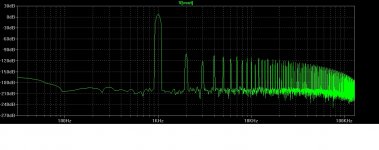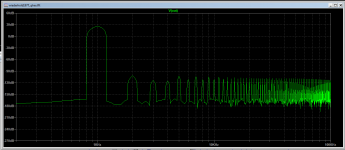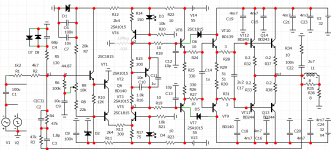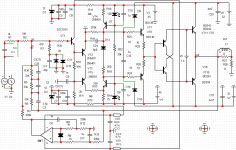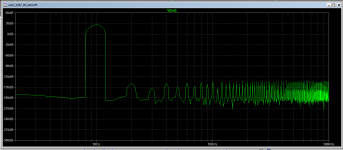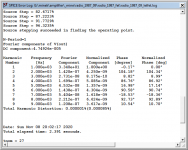What's a reasonable quiescent for the Wieder QuasiHex?, 40, 100, or 150 mA? In the sim doesn't make a huge difference. (45V rails,LT1056, diode, IRFP240s with 0.47Rs)
For whole amp or per output transistor?
Are you sure? I'm running at 35mA (each transistor).
Higher than that - it doesn't make much difference (sim & oscilloscope).
All the fet amps I built before never run higher than 50mA per transistor
(except for class A).
Are you sure? I'm running at 35mA (each transistor).
Higher than that - it doesn't make much difference (sim & oscilloscope).
All the fet amps I built before never run higher than 50mA per transistor
(except for class A).
Today I've built a board for 2nd channel.
Tested, and no surprises, works the same as the 1st one.
Now time for building chassis and proper heatsink..
Waiting for ordered materials.
Tested, and no surprises, works the same as the 1st one.
Now time for building chassis and proper heatsink..
Waiting for ordered materials.
35 / 150 mA (per device), conditions of post #341
Attachments
Last edited:
To me it looks the same...
Try without source resistors. If using just one pair they won't be needed...
This is from my sim. 35mA idle current. FQA fets.
Try without source resistors. If using just one pair they won't be needed...
This is from my sim. 35mA idle current. FQA fets.
Attachments
Last edited:
IMD is more important. Wiederhold's double CCS current drive VAS has 0,003% (89dB) IMD (with LTP input, IRFP outputs: 14+15kHz - 50W @ 8 Ohm, measured).
Last edited:
This is the simplest version of Wiederhold amplifier. The opamp reduced practically to a single transistor. This is Valery's "vSingle" IPS. Result a current feedback singleton input, current drive VAS: fast and linear.
"Open loop 1KHz THD is less than 0.05%, with 40db NFB it comes down to 0.0005%, showing around 0.001% in combination with VHex+ OPS (50W @ 8 ohm, +/-50V rails). 2-nd and 3-rd harmonics are dominant, all the rest are significantly lower. Simple light compensation, good stability margins."
"Open loop 1KHz THD is less than 0.05%, with 40db NFB it comes down to 0.0005%, showing around 0.001% in combination with VHex+ OPS (50W @ 8 ohm, +/-50V rails). 2-nd and 3-rd harmonics are dominant, all the rest are significantly lower. Simple light compensation, good stability margins."
Attachments
Last edited:
These numbered are measured or sim-ed?
Based on uploaded pix it is sim. Nevertheless, it is impressive: Sons of VHex
This is the simplest version of Wiederhold amplifier. The opamp reduced practically to a single transistor. This is Valery's "vSingle" IPS. Result a current feedback singleton input, current drive VAS: fast and linear.
"Open loop 1KHz THD is less than 0.05%, with 40db NFB it comes down to 0.0005%, showing around 0.001% in combination with VHex+ OPS (50W @ 8 ohm, +/-50V rails). 2-nd and 3-rd harmonics are dominant, all the rest are significantly lower. Simple light compensation, good stability margins."
Neophyte.Неофит. Discrete amplifier
Attachments
Neophyte.Неофит. Discrete amplifier
Looks good. What do you think about adding a dc servo to the circuit? Maybe LM78xx voltage regulators instead of 15V zeners?
How you gonna feed LM78xx from over 40V rails?
Too much voltage...
As for servo - this topology has very stable DC offset.
2mV, and doesn't seem to change...
I'm reffering to the op-amp version, not the single transistor input...
It doesn't make much sense to use single transistor input (why? to save 50 cents over op-amp?),
and then put op-amp as a servo...
Too much voltage...
As for servo - this topology has very stable DC offset.
2mV, and doesn't seem to change...
I'm reffering to the op-amp version, not the single transistor input...
It doesn't make much sense to use single transistor input (why? to save 50 cents over op-amp?),
and then put op-amp as a servo...
Last edited:
Ordinary Zener diodes are enough. But not rationally. It is easier to put an operational amplifier on the inputLooks good. What do you think about adding a dc servo to the circuit? Maybe LM78xx voltage regulators instead of 15V zeners?
Attachments
Last edited:
Lomakin Parshin + LatFets
Does this profile look ok?
Lomakin Parshin + LatFets : simplier, smaller, and sims better.
Judging from the BJT version built previously, this will work perfectly..
Thd at 44kHz: 0.0025%
I think the best way for high quality and simple amp, is to go with LatFets, even if it's more costly..
No drivers, no heatsinks for them, no temperature sensor, no source resistors, and great results.
LatFet version of Wiederhold amp performs beautifully for the last 5 days, playing non-stop..
Does this profile look ok?
Lomakin Parshin + LatFets : simplier, smaller, and sims better.
Judging from the BJT version built previously, this will work perfectly..
Thd at 44kHz: 0.0025%
I think the best way for high quality and simple amp, is to go with LatFets, even if it's more costly..
No drivers, no heatsinks for them, no temperature sensor, no source resistors, and great results.
LatFet version of Wiederhold amp performs beautifully for the last 5 days, playing non-stop..
Attachments
Last edited:
minek,
Yesterday I was already playing with the sim and sent you the asc file with D5 added to the schematic and also D8 changed to a RED LED to see how distortion profile has changed.
Today, I replaced Q2 for 2SA1381C, distortion profile is much better indeed.
I've been using MJE transistors, because I have lots of them.
Not because I particularly like them in VAS.. 🙂
Try TTA/TTC devices, perhaps they will be very good too...
Update: I tried them, not as good in sim as 2SA/2SC pair.
Last edited:
- Home
- Amplifiers
- Solid State
- Unusual amp from 1987

